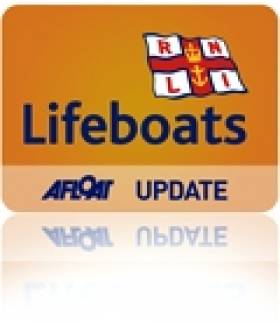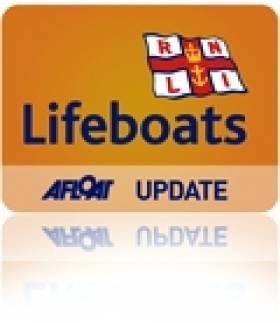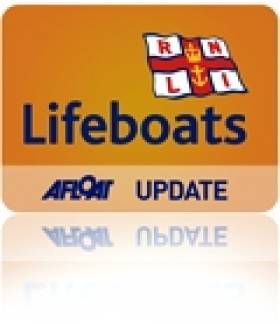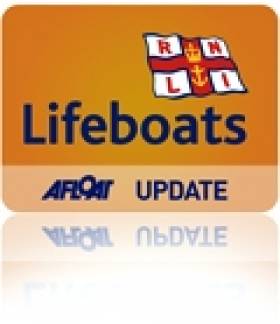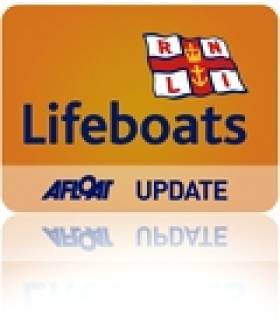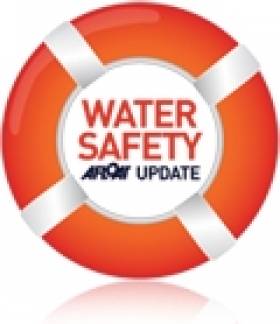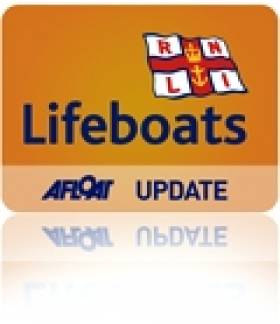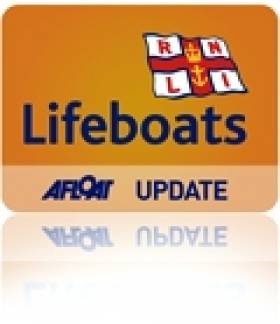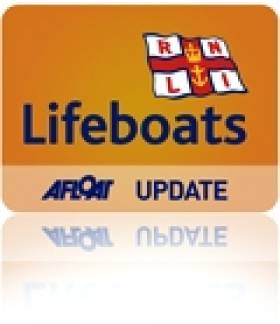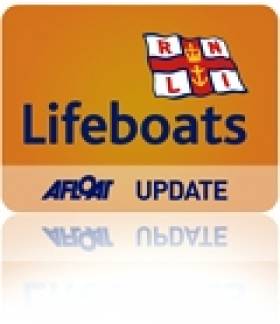Displaying items by tag: Lifeboats
RNLI Crews Assist Windsurfer, Stricken Fishing Boat in Co Down
#RNLI - Portaferry RNLI rescued a windsurfer who got into difficulty off the Co Down coast yesterday (16 April).
The volunteer crew launched their inshore lifeboat before 5pm yesterday evening to go the aid of the injured windsurfer reported to be in the area of Pig Island, a small island in Strangford Lough close to Newtownards Sailing Club.
The weather at the time was described as blowing slight to moderate winds with good visibility.
The crew was on scene at 5.15pm where they found the man on Pig Island accompanied by two other men. The windsurfer, who was suffering from a shoulder injury, was transferred to the lifeboat and made comfortable before being taken to the sailing club, where he was then transferred into the care of the coastguard and passed to the ambulance service to be taken to hospital.
Speaking after the rescue, Portaferry RNLI lifeboat operations manager Brian Bailie said: "As the charity that saves lives at sea, we will always respond to any call for help where someone is in danger.
"Strangford Lough is a popular destination for a wide range of water sport enthusiasts and it is important that they take all necessary precautions when using the lough.
"As we are all aware, accidents can and do happen and it is at such times that the work carried out by the volunteer crews of the RNLI is so important."
Elsewhere in Co Down yesterday, Bangor and Donaghadee RNLI assisted a fisherman whose 28ft commercial fishing boat experienced engine failure.
The crew quickly located the disabled boat one mile west of the Copeland Islands at the mouth of Belfast Lough yesterday morning after 11.15am.
With the vessel drifting closer to the island shores and the wind gusting gale force eight, a tow line was quickly rigged and passed to the fishing boat. Bangor RNLI was escorted by Donaghadee RNLI's all-weather lifeboat as it towed the fishing vessel to the safety of Bangor Harbour.
Bangor RNLI volunteer helm Peter Scott, who was involved in this rescue, said: "Engine failure close to shore could lead to a life threatening situation. We always urge everyone going to sea to make sure their electrical systems and engine are well maintained and in good working order. A good anchor and chain should always be carried as part of essential safety equipment.
"We are glad the skipper of this vessel is now safely ashore," he added.
Lifeboat Roundup: Windsurfers Rescued In Waterford; Boats Aground in Wexford, Lough Erne
#RNLI - The Dunmore East RNLI lifeboat was tasked yesterday (7 April) to assist two windsurfers in difficulty near Duncannon in Waterford Harbour.
In rough conditions yesterday afternoon, with south-east winds force 6/7 blowing, coxswain Pauly Daniels reached the casualties' position within 30 minutes.
By this stage one of the surfers had made it ashore safely at Duncannon. The Dunmore East lifeboat quickly located the other windsurfer a quarter of a mile north of Duncannon. The casualty was safely recovered from the water and landed ashore nearby.
Neither casualty was injured and did not need medical attention.
Nearby in Wexford, five teenagers were rescued from a small speedboat after it suffered engine failure and ran aground on the River Slaney around 1.20pm yesterday.
According to Lorraine Galvin, volunteer press officer at Wexford RNLI, the teens' "fast call for help to the coastguard greatly helped in ensuring their speedy rescue in cold, rough weather conditions".
At the time of the rescue there were wind speeds of force 5 south-easterly and a rough sea state. All of the passengers were starting to suffer from the cold and were treated for mild hypothermia.
Meanwhile, on Upper Lough Erne last Friday the volunteer lifeboat at Enniskillen RNLI (Carrybridge) launched to reports of a vessel that had run aground.
The RNLI lifeboat and rescue water craft were both launched and proceeded to the casualty's last known location 2.5 miles upstream from Carrybridge at Innishmore viaduct.
On route to the scene at the Innishmore viaduct, the volunteer crew got further information that the vessel had managed to refloat and was currently at Killygowan Island.
A full inspection was carried out and none of the crew on the casualty vessel were found to be in need of medical attention.
It was decided with the owner's permission that the volunteer crew would escort their vessel back to Carrybridge with the lifeboat leading and rescue water craft following as the navigation lights were not working.
Butcher Couple Eschews Anniversary Gifts for RNLI Donation
#RNLI - Rather than accept gifts for their 50th wedding anniversary, a Portstweart couple have asked their family and friends to make donations to Portrush RNLI.
As the Coleraine Times reports, Ewart Toms and his wife - who are well known butchers in the area - raised £500 for the RNLI which they were more than happy to hand over to lifeboat station volunteers at Portrush.
They said: “We wanted to mark this special occasion in our lives, by making a donation to a cause close to our hearts, and to the volunteers who risk their lives to save others.”
The Coleraine Times has more on the story HERE.
Enniskillen RNLI Assist Sinking Vessel on Lough Erne
#RNLI - Enniskillen RNLI at Carrybridge was tasked on Tuesday afternoon (2 April) by Belfast Coastguard to reports of a boat taking on water and sinking on Lough Erne.
The lifeboat travelled 4km towards Enniskillen to the last known position of the sinking vessel. On arrival at the scene, the lifeboat crew saw that the occupants of the vessel were on land and that the vessel had been secured to a tree on the bank, though it was still taking on water.
The voluntary crew checked that everyone was present and there were no injuries. Once this was established, the lifeboat crew assessed the casualty vessel and found that the bung was missing.
They located two corks and these were made into a temporary bung. A salvage pump was set up and the water was removed.
The owner of the vessel was contacted and came to the scene. The vessel was judged by the RNLI crew to be capable of making the short distance back to Carrybridge where it was recovered onto a trailer.
Busy Days For RNLI Lifeboats In Co Down
#RNLI - Newcastle RNLI’s always-on-call lifeboat crew had to abandon their buckets and sponges during a fundraising car wash at the weekend to respond to an emergency at the Co Down town’s harbour.
The RNLI volunteers were busily soaping and rinsing cars for their annual Easter fundraiser on Saturday when they were alerted to a woman in trouble in the freezing water a few yards from one of the piers.
The car wash was immediately abandoned and within minutes the inshore lifeboat Aldergrove II was launched and rushed to the woman’s aid.
At the same time, crew member Shane Rice grabbed a lifebelt from the pier and jumped into the water to assist the woman. He kept her afloat while the Aldergrove II came alongside.
The woman was helped into the rescue inflatable, wrapped in blankets to prevent hypothermia, and taken back to shore where an ambulance was waiting to take her to hospital.
Newcastle RNLI’s deputy launching authority Clifford Moorehead said afterwards: "The lifeboat crew are always ready to respond in an instant to any emergency. It is fortunate that the car wash was in progress at the time and the crew members were on hand to swiftly deal with this case.
"After the rescue the crew members came back to the harbour and resumed their car wash. It’s just all in a day’s work for the RNLI."
It wasn't the only callout of the weekend for the RNLI in Co Down, as Bangor RNLI assisted a lone sailor who got into difficulty on a sailing dinghy Easter Sunday.
At 1.10pm the volunteer lifeboat crew received an urgent request from Belfast Coastguard to launch the lifeboat and rescue one person from a 17ft dinghy.
The sailing dinghy had reportedly gone aground on ‘Cockle Island’ off Groomsport Harbour on the southern shores of Belfast Lough.
Upon arrival at the scene, the volunteer crew found that the occupant onboard the dinghy had been assisted by another boat owner and the vessel had been safely tied to a mooring buoy.
Meanwhile, last Wednesday evening Portaferry RNLI was launched to reports that red flares has been sighted on Strangford Lough off Kircubbin in Co Down.
They were joined by a coastguard team that searched the shoreline and after some time recovered a spent flare casing. The inshore lifeboat and its volunteer crew were stood down after a number of hours with the callout proving to be a false alarm.
Portaferry RNLI lifeboat operations manager Brian Bailie said: "A member of the public acted in good faith ... alerting the emergency services to what they understood to be a distress flare on the lough."
He reiterated that flares "should only be used in emergency situations".
NI Lifeguards To Feature In New TV Series
#WaterSafety - RNLI lifeguards in Northern Ireland are to feature on a new television series on UTV.
The Magazine starts on Sunday 7 April at 7.30pm with host Sarah Travers in her home town of Portstewart to introduce viewers to some of her favourite people, places and topics.
As part of the first programme, TV presenter Emma-Rosa Dias will find out what it takes to be a lifeguard with the RNLI when she visits the charity’s area support centre in Ballymoney - before being put through her paces by RNLI lifeguard supervisor Tim Doran to see if she is ready for the challenge.
After a test in the swimming pool, Dias experiences a slice of the real thing when she pays a visit to Portrush East Strand on the Causeway Coast, one of the five beaches in Northern Ireland which begins its Easter season on Good Friday tomorrow 29 March.
As previously reported on Afloat.ie, this lifeguard cover will run throughout Easter week until Sunday 7 April.
Filming took place on Monday afternoon and despite the unseasonal weather, the charity’s highly trained lifeguards took the opportunity to demonstrate that they will be ready to assist the visitors who will brave the elements and take a trip to the seaside over the Easter break.
Speaking following the afternoon’s shoot, Tim Doran said filming with UTV was a great way to show how highly trained RNLI lifeguards are.
"Our lifeguards spot potential dangers before they develop, and are on hand to give appropriate safety advice and respond immediately if anyone gets into difficulty," he said. "Because our lifeguards work closely alongside our volunteer lifeboat crews, it means the RNLI offers beach-goers and water-users a seamless rescue service from beach to open sea."
While Easter is often the time when people are getting back in the water after the winter, and while it’s good to see people enjoying the beaches, the RNLI is encouraging visitors to make sure they have the right kit to keep warm.
"It’s much colder now then it was this time last year," Doran added, "and our lifeguards will be wrapping up and we’d encourage everyone else to do the same. So, if you are heading into the sea, make sure you’re wearing a good wetsuit or drysuit, go with other people and keep an eye on each other.
"Keeping warm in cold weather can take a lot of energy, so fatigue can be an issue, plus watch out for the wind chill factor – even a slight breeze can have a dramatic effect on how cold it feels."
Meanwhile, to find out how Emma-Rosa Dias gets on, tune into UTV at 7.30pm on Sunday 7 April.
Howth Duo Cycling From London To Paris For RNLI
#HowthRNLI - Howth locals Jennifer Murphy and Brendan Mulligan will be taking part in the London to Paris Bike Ride in aid of Howth RNLI.
The 377km charity challenge will take place between 23 and 26 August. Riders will depart from London and cycle past Hampton Court and through the North and South Downs to Portsmouth.
After crossing the English Channel on a ferry they will arrive in France at Caen and travel through the French countryside to Evreux. On the final day, all the cyclists will head to their final destination of the Arc de Triomphe in Paris.
Murphy said: "We decided to do the challenge for Howth RNLI because it is a local charity. We know some of the volunteer crew, including my boss!"
The duo are collecting sponsorships at their MyCharity.ie page HERE.
And according to Howth RNLI's Rise Michael, the funds they raise will ensure the north Dublin volunteer lifeboat crews can go to sea with the best equipment available, preserving their safety when saving lives at sea.
Meanwhile, Howth RNLI is hosting a 'boat jumble' sale at Howth Sea Angling Club from 10.30am to 1pm on Saturday 13 April.
All are welcome to bring along boat gear, fishing gear, dinghies, wetsuits, sails, books and any other nautical-related items.
Tables cost €20 each, with 25% of sales donated to the RNLI. Alternatively, items can be donated to ‘The Bosun’s Locker’ with all sale proceeds going to the RNLI.
The RNLI Sea Safety Team will be on hand to check lifejacket safety and give advice, and RNLI souvenirs will also be available. For more details contact Barbara Sargent on 01 832 5392 or Rose Michael on 087 255 2726.
Michael adds that the funds raised by the jumble sale will go towards Howth RNLI's current fundraising project to fund the running and maintenance costs of the lifeboat station for a week.
Fenit RNLI Bid to Save Stranded Dolphin
#rnli – Lifeboat crew with Fenit RNLI and three local families worked together last night (Tuesday 26 March) to save the life of a stranded dolphin in the Kerry town. The mammal was running out of time after he was washed up into a deserted channel on a remote beach on Fenit Island and was not able to return to the water.
In a rescue operation that involved members of the Egan, Tobin and McCarthy families, three RNLI volunteer lifeboat crew, an inshore lifeboat and a jeep, the dolphin was given a fighting chance and was safely deposited by the lifeboat crew out in deep water.
The drama began when local woman Breda McCarthy was out walking her dog on Fenit Island when she came upon the stranded dolphin. It was lying in a small channel quite a few metres from the sea. It is believed the dolphin had swam in at high tide a few hours earlier and had got cut off from the sea. Mrs McCarty contacted family members who came down to see if they could return the dolphin to the water. Unfortunately this was not possible as the mammal kept to the shallow waters and would not return to the sea.
With their concern growing the families contacted Ger O'Donnell, Fenit RNLI Lifeboat Operations Manager to see if the RNLI could assist them. Ger in turn made contact with Valentia Coast Guard who put him in contact with a dolphin expert. After discussing the situation with the expert it was decided that the best course of action for providing a safe outcome would be to transport the dolphin down to the harbour and then transport it by RNLI lifeboat out to sea to be released.
The dolphin was carefully wrapped up and transported by jeep to the harbour where RNLI lifeboat crew were already waiting in the inshore lifeboat to launch. They took the dolphin onboard the lifeboat and proceeded immediately out to sea. On releasing the dolphin into the water the lifeboat crew watched as the mammal slowly started to swim around the lifeboat in ever increasing circles, gaining confidence as it went. Once they were satisfied the dolphin was able to safely swim away, the lifeboat crew returned to shore.
Commenting on the unusual callout Fenit RNLI Lifeboat Operations Manager Ger O'Donnell said, "This was not your run of the mill rescue for the lifeboat crew. We were very anxious that we did everything right and gave the poor thing the best chance of survival. I want to thank everyone involved. It was a real community effort, from the local families, the RNLI crew and the Coast Guard, who were able to put us in touch with the expert advice we needed. It was almost as if the dolphin knew we were working to save him and I sincerely hope that he made it and we can count him as another life saved."
Local woman Mary Tobin, whose son Michael captured some photos of the incident said, "It was great to see everyone working together. I can't thank them enough, we were so worried the poor creature was not going to make it. When my sister Breda found him it was clear that he was in a bad way and his breathing was very laboured. We knew that with the RNLI on our doorstep that we would have a good shot at a successful outcome.
Dun Laoghaire Lifeboat Crew Give it Some Welly
#rnli – With the recent downpours, the RNLI is calling on people to put their wellies to good use and support their forthcoming MAYDAY appeal. The charity that saves lives at sea is asking the public to hold a welly themed fundraising event or buy a special yellow welly RNLI MAYDAY key-ring to raise funds for the lifeboat service in Ireland. The RNLI MAYDAY appeal is supported by John West.
The yellow welly is an essential piece of the RNLI volunteer lifeboat crewmember's kit. Waterproof with steel-capped toes, the specially designed boots keep the volunteer crew's feet warm and dry while also protecting them in dangerous conditions on deck. During gale force winds, rain and ice, keeping a sure footing can literally mean the difference between life and death for our volunteers. A pair of yellow wellies for a volunteer costs €50 but supporting the RNLI's MAYDAY appeal and buying a yellow welly key-ring will cost just €2.
RNLI MAYDAY is set to run from the first to the sixth of May with yellow welly key-rings being sold by volunteers in many shopping centres and towns around Ireland. Companies can also request a box of the MAYDAY key-rings to sell in their work place or hold their own welly fundraiser.
RNLI Corporate Manager Rhona O'Connor said, "We are asking people to give it some welly and get behind RNLI MAYDAY. Wellies are something that we are all too familiar with recently. Whether it's for getting around in bad weather or attending festivals and outdoor gigs, we love our wellies. The RNLI volunteer lifeboat crew love their wellies too and want people to help them raise funds. So whether it's a wear your wellies to work fundraiser or simply buying a yellow welly MAYDAY key-ring we hope people will give it some welly for the charity which has been saving lives since 1824."
Supporting MAYDAY Dun Laoghaire RNLI volunteer crewmember Rob Landers commented, "We are delighted to be associated with the RNLI MAYDAY appeal. As a volunteer crewmember I benefit directly from the training and the equipment that the charity provides for its lifeboat crew. We rely on the support and the generosity of the public to ensure the lifeboat crews based around Ireland can continue to save lives at sea and on inland waters."
The RNLI MAYDAY appeal is proudly supported by John West who themselves have a long seagoing tradition. Since 1857 the company has had their own fleet of fishing boats. John West Chief Executive Brendan Murphy added, "At John West we know first-hand the reality of the power of the sea, and we fully appreciate and support the work that the RNLI do in saving lives everyday throughout Ireland."
Last year RNLI lifeboats in Ireland launched 939 times to bring 1,041 people to safety. Volunteer lifeboat crew answer all types of maydays. It was a busy few days for the RNLI around the country with Wicklow RNLI launched last Friday in gale force conditions to bring a French fishing vessel with four people onboard to safety. While yesterday (Monday 25 March) Howth RNLI launched their inshore lifeboat when a father and daughter became stranded on the East pier due to high waves. The pair were taken onboard the lifeboat after a crewmember walked them to safety, through breaking waves, from the alcove where they were sheltering. In Cork Ballycotton RNLI launched to rescue a lone sailor in difficulty. On arrival at the scene, lifeboat crew boarded the vessel and took the man onboard. The decision was made to have him airlifted by the Irish Coast Guard helicopter from Waterford and taken to hospital for treatment.
Events already planned for RNLI MAYDAY include a welly walk down Dun Laoghaire pier in Dublin on Sunday 5 May, an open water swim in Dunmore East, Waterford and the Sherkin Island to Baltimore sea swim in west Cork, also on the Sunday. For a list of scheduled events, fundraising ideas and to register an event visit: www.rnli.org/MAYDAY or call: 01895 1837
Portrush Boatowners look forward to Annual Boat Jumble
#boatjumble – Portrush Boatowners Association is eagerly looking forward to the annual boat jumble at Portrush Harbour on Saturday 30th March 2013.
The boat jumble which is usually held in October was rescheduled to Easter Saturday, so that visitors to Portrush could enjoy the event, which combines a gathering of the local boatowners raising funds for charity and a bit of banter and craic. The Charities benefitting this year are Chest Heart and Stroke and Portrush Lifeboat Station.
The jumble takes place on the North Pier and consists of stalls and car boots selling all things nautical and maybe not so nautical. It gives boatowners a chance to buy boating paraphanalia as well as maybe the odd boat up for grabs.
The local Coastguard will be on hand to give Sea Safety advice and the Portrush Lifeboat will hopefully be alongside side with her crew, which offers an excellent opportunity to have a tour of the lifeboat and ask the crew questions about how she works.
Also this year the Association have asked local men Andy McClelland and John Lynn to come along with their boats.
John is planning to sail solo from Islay to Portrush in his laser dinghy retracing the steps of his late father Robert who made the same journey on a windsurfer. John will also be raising funds for Portrush Lifeboat Station.
Local Lifeboat crew member and Junior World Kayaking Champion Andy McClelland wil be kayaking 22 miles across the Irish Sea in May in aid of kidney research, Alzheimers Society and the regional respiratory Belfast City Hospital.
There will be an opportunity to talk to both John and Andy about their plans.
Charlie Grossie Chair of the Portrush Boatowners Association commented:-
'"The Association is yet again proud to be able run the Boat Jumble in support of the RNLI and the NI Chest Heart and Stroke charities. We are hoping for good weather and good turn on the day. We look forward to being able to make a healthy donation in support of both charities".
The Boat Jumble starts at 10am to 3pm on 30th March 2013. Stalls/Cars caost £25 and entry fee is £3 for adults, children get in free.



























